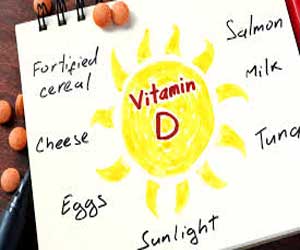- Home
- Editorial
- News
- Practice Guidelines
- Anesthesiology Guidelines
- Cancer Guidelines
- Cardiac Sciences Guidelines
- Critical Care Guidelines
- Dentistry Guidelines
- Dermatology Guidelines
- Diabetes and Endo Guidelines
- Diagnostics Guidelines
- ENT Guidelines
- Featured Practice Guidelines
- Gastroenterology Guidelines
- Geriatrics Guidelines
- Medicine Guidelines
- Nephrology Guidelines
- Neurosciences Guidelines
- Obs and Gynae Guidelines
- Ophthalmology Guidelines
- Orthopaedics Guidelines
- Paediatrics Guidelines
- Psychiatry Guidelines
- Pulmonology Guidelines
- Radiology Guidelines
- Surgery Guidelines
- Urology Guidelines
Most kids' multivitamin brands misleading, don't contain recommended Vitamin D dose

Most kids' multivitamin products don't contain the recommended daily Vitamin D dose. Only a few such multivitamin products have recommended daily vitamin D dose of 400 IU, according to the results of a survey of 91 different products.
It was found that the supplements containing only vitamin D or labelled specifically 'for healthy bones' typically had a higher vitamin D content. The study results have been published online in the Archives of Disease in Childhood.
Public Health England recommends a daily dose of 400 IU (10 ug) all year round for all 1-4-year-olds, and during the autumn and winter months for adults and children over the age of 4.
Vitamins are important for the well-being of an individual as they help in the smooth functioning of a number of body systems. Different vitamins have different significance and these are present in varying quantities in a range of foods. Vitamin D, also known as the sunshine vitamin, is one of the most important nutrients.
Low levels of vitamin D are common in children, particularly during the winter. Vitamin D deficiency can lead to rickets and abnormally low levels of calcium in the blood called hypocalcaemia.--conditions that can be prevented by taking vitamin D supplements.
The Healthy Start scheme, a public health initiative for low-income families in England, provides free multivitamins. But these products contain only 300 IU per day of vitamin D, prompting the researchers to see if other children's multivitamins sold in the UK might contain less than the recommended amount.
In September 2018, they searched the websites of nine UK supermarkets and high street health product retailers, looking for multivitamins aimed at children under the age of 12.
A product was considered a multivitamin if the packaging or manufacturer's website included the word 'multivitamin' or a version of this, or if more than one vitamin was named.
They also looked at products labelled as a vitamin D supplement, or which suggested they could help with 'healthy bones'.
If a dose range was advised, they recorded the highest amount, to quantify the daily amount of vitamin D provided.
The researchers found 67 multivitamins, made by 24 different manufacturers, and 24 vitamin D/healthy bones products aimed at children under the age of 12.
The daily vitamin D dose in the multivitamins surveyed ranged from 0 to 800 IU.
Only one multivitamin was suitable for use from birth, supplying 200 IU/day of vitamin D, while for children over 6 months, only between a quarter and a third (25-36%) of the available products supplied at least 400 IU/day.
Some of the products giving a dose range would only supply the recommended vitamin D level at the highest dose.
The vitamin D/healthy bones products supplied between 50 and 1000 IU of vitamin D a day. Six were suitable for use from birth, five of which contained 340-400 IU of vitamin D.
The vitamin D content of these types of the supplement was typically higher than that of multivitamins: nearly two thirds (57-67%) contained at least 400 IU/day. But one product labelled as 'for bones and relaxation' contained only 50 IU/day of vitamin D.
The researchers point out that their survey was limited to supplements sold by UK retailers, and many other supplements are available from online retailers, including imported products and fortified food products.
But because multivitamins are classed as food products, under European Union regulations, the permissible vitamin D content can range from 20% below to 50% above, the amount stated on the label, they say.
"There is a wide range of both multivitamins and vitamin D supplements available for children in the UK, yet most of these do not provide the recommended 400 IU/day," they write.
To obtain this, children would either have to take over the recommended dose, which may increase the risk of toxicity from the other components, or they would have to take a combination of vitamin D and multivitamins, which is more expensive, explain the researchers.
Parents and caregivers need to check that the multivitamins they buy for children contain at least 400 IU/day, they advise.
For more details click on the link: doi/

Disclaimer: This site is primarily intended for healthcare professionals. Any content/information on this website does not replace the advice of medical and/or health professionals and should not be construed as medical/diagnostic advice/endorsement or prescription. Use of this site is subject to our terms of use, privacy policy, advertisement policy. © 2020 Minerva Medical Treatment Pvt Ltd